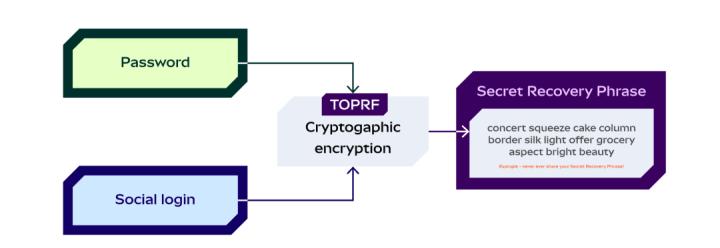Author: Animoca Brands Research; Compiled by: Felix, PANews
This report analyzes over 3,000 spot token listing events across 9 major centralized exchanges (CEXs) and more than 120 decentralized exchanges (DEXs) in 2024. The purpose is to assess the overall trends in token listings on various platforms and evaluate the price and trading volume performance of these tokens during the events.
Key Findings
Centralized exchanges adopt different strategies to determine listing priority, focusing on different fully diluted valuation (FDV) levels. Exchanges with fewer listings tend to prioritize tokens with larger FDVs (over $500 million), while those with higher listing frequencies tend to favor tokens with FDVs below $30 million.
Listing activity is closely correlated with the price trend of Bit, increasing during bull markets and decreasing when Bit stagnates. While all FDV scales are affected by this trend, larger FDV tokens are more sensitive to changes in market sentiment.
Price performance, measured by 7-day and 30-day changes relative to the closing price on the listing day, largely reflects Bit's price trends, but there are indeed differences between exchanges. A "smile curve" pattern emerged: exchanges with the highest (e.g., Binance) and lowest (e.g., MEXC) average listing FDVs recorded positive price changes, while mid-tier exchanges (e.g., Bybit, Bitget) saw the largest declines.
In terms of trading volume, Binance leads in trading volume for newly listed tokens, followed by OKX and Upbit. Notably, Upbit's first 24-hour trading volume is comparable to Binance's, while OKX leads in trading volume for tokens in the $30 million to $100 million FDV range.
Tokens that debut on DEXs and have an FDV value over $30 million perform on par with those that debut on mid-tier CEXs. The price performance of tokens debuting on DEXs (measured by changes from day 2 to day 7 and day 30) outperforms 4 out of 5 mid-tier CEXs. The first 30-day trading volume is also similar or higher than CEXs like Kucoin, Gate, and MEXC.
It is not uncommon for DEX-debuted tokens to later appear on mid-tier CEXs, but it is less common for them to appear on large CEXs. Of the DEX-debuted tokens sampled in the second half of 2024, about 16% later listed on CEXs, with only 2% successfully listing on large exchanges like Binance, OKX, or Upbit.
CEX Listing Performance
Overview
The report recorded a total of 3,074 token listing events. 1,226 events (40%) were identified as primary listings, listed within the first 2 days of token release; while 1,848 events (60%) were identified as secondary listings.
Most exchanges took a balanced approach, with the proportion of primary and secondary listings being roughly equal.
Generally, exchanges that list higher FDV projects focus on fewer, larger-scale listings, while those that list smaller FDV projects have more listing events.
The two Korean exchanges, Upbit and Bithumb, primarily focus on secondary listings, so primary listings may not be the first time they list a token. In the rest of this paper, exchanges will be sorted by their average listing FDV, with those with higher listing FDVs referred to as "large exchanges" and the rest as "mid-tier exchanges".
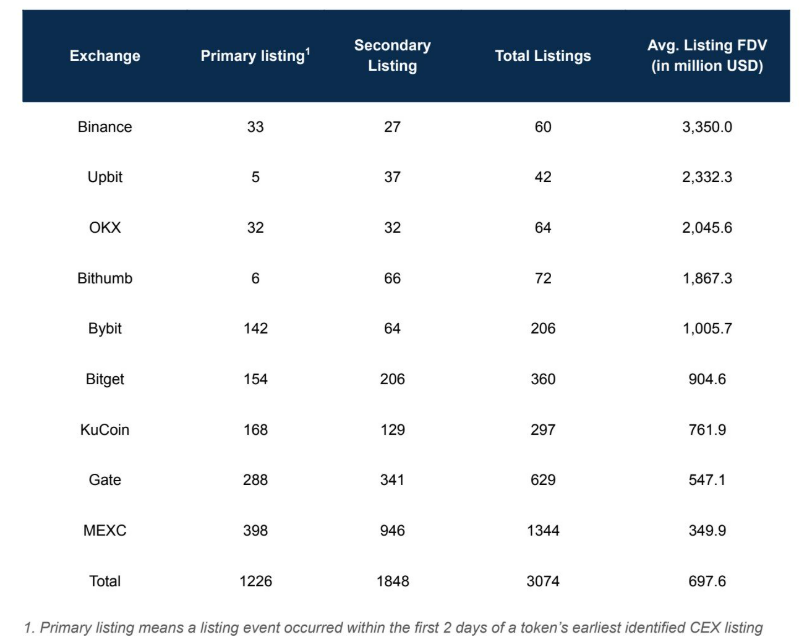
Monthly Summaries of Listing Events
Listing events were more numerous during bull markets (February to March and August to December), while declining during market downturns.
April was an outstanding month, with listing events continuing to rise despite a reversal in Bit price. This impact was not as evident in December, when Bit stagnated again after two months of increases.
In terms of the number of listing events, top exchanges were less affected by bear markets, as reflected in their increasing share of listing events during these periods.
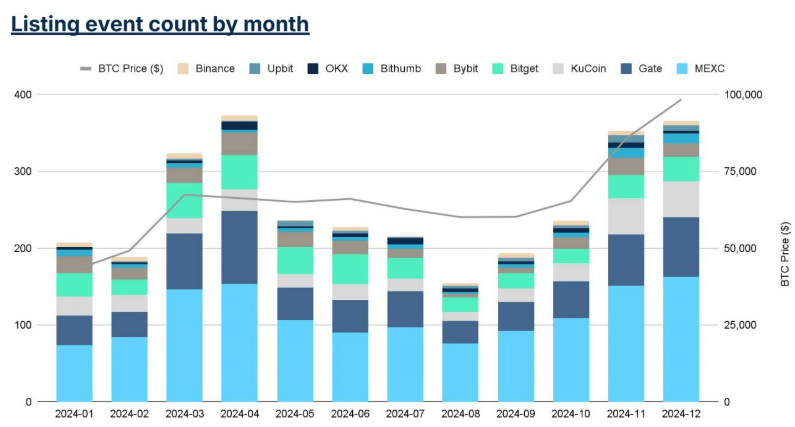
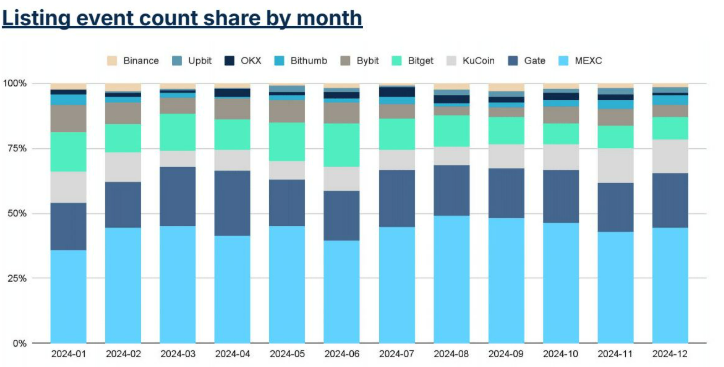
Listing Events Summarized by FDV
Large exchanges concentrate most of their listing efforts on the over $500 million FDV category, with the top four exchanges accounting for 25% of activity in this tier.
Nevertheless, mid-tier exchanges still contribute the majority of listing activity for the over $500 million category, likely because large exchange projects often co-list on mid-tier exchanges, but the reverse is less common.
Mid-tier exchanges like Bybit, Kucoin, Bitget, and Gate have more balanced listing volumes across the four FDV tiers, with a slightly higher share in the $30 million to $500 million range. MEXC takes a different approach, focusing on tokens with FDV ≤ $30 million, which account for 70% of its listing activity.
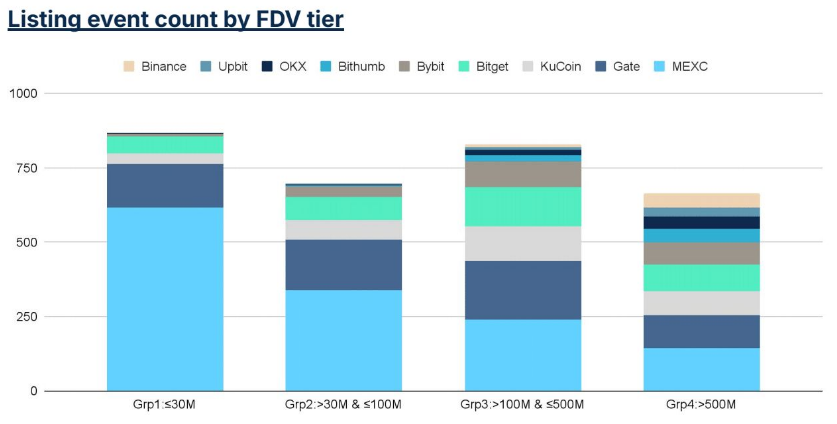
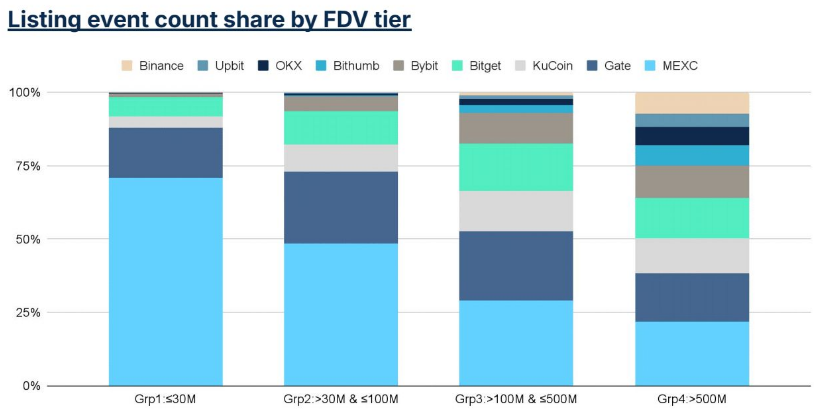
Monthly Listing Events by FDV Tier
The over $500 million FDV tier is the most sensitive to changes in market sentiment, with listing events rapidly increasing during the February to March rally, exceeding expectations in April, and then contracting until the September to December rally.
The ≤$30 million FDV tier closely tracked the overall listing momentum during bull markets, but occupied a larger share of listing events in periods like June to September.
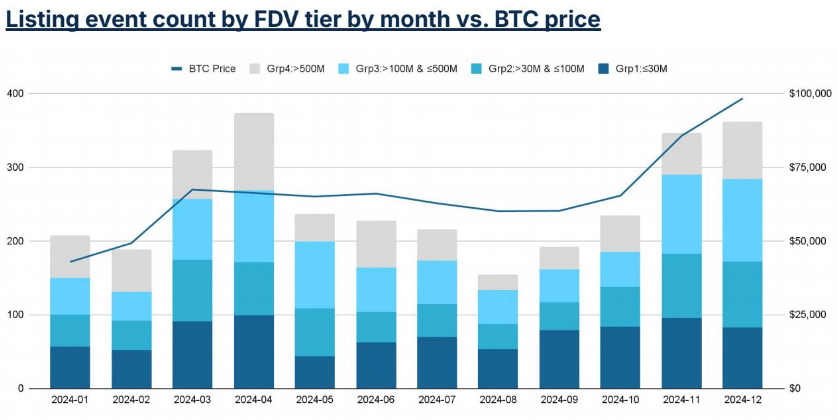
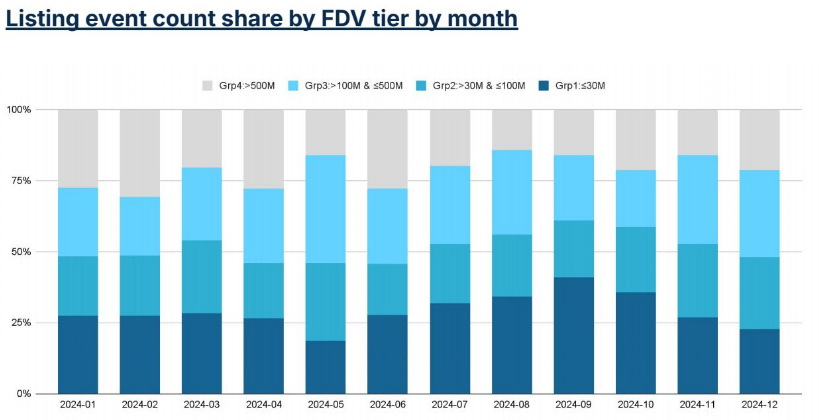
Listing Price Performance
The price performance of tokens listed on different exchanges forms a "smile curve", with those at the two ends (Binance and MEXC) outperforming those in the middle.
Tokens listed on Binance and MEXC saw positive price changes 30 days after listing, while the average price of those listed on Bybit and Bitget declined by around 10%.
The 7-day price performance exhibits a similar pattern, with Binance listings gaining around 3% and MEXC listings remaining flat, while mid-tier exchanges saw larger declines.
Median price changes are typically lower than the averages, indicating that a small portion of listing events account for the majority of the performance.
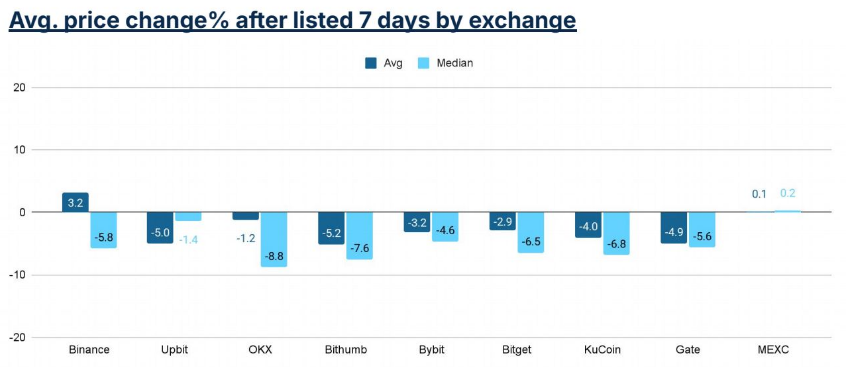
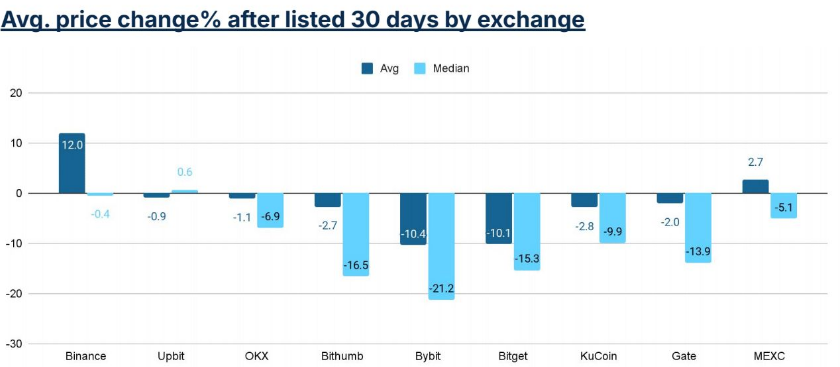
Price Performance Summarized by FDV Tier
The patterns of 7-day and 30-day price changes differ by FDV tier.
Tokens in the ≤$30 million FDV tier saw price declines in 7 days but staged a strong rebound by day 30, exhibiting the largest contrast among the four tiers. Tokens in the $30-100 million and >$500 million FDV tiers saw moderate declines in 7 days and maintained similar levels on average by day 30.
Tokens in the FDV range of $100 million to $500 million fell 2% in the first 7 days, but the decline expanded to over 11% by day 30, indicating an overall downward trend after the first week.
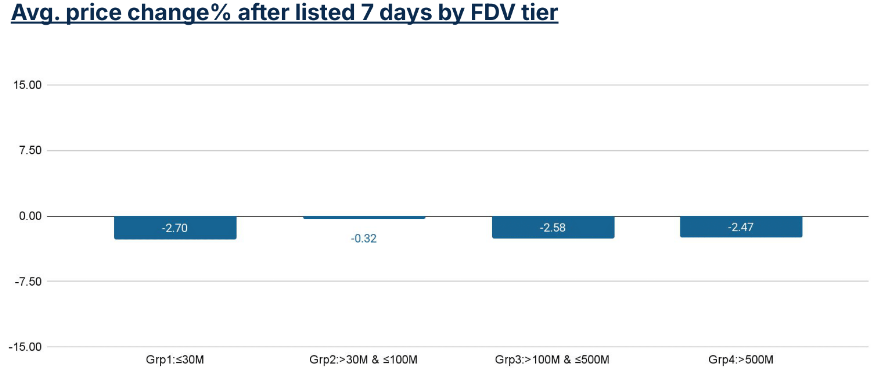
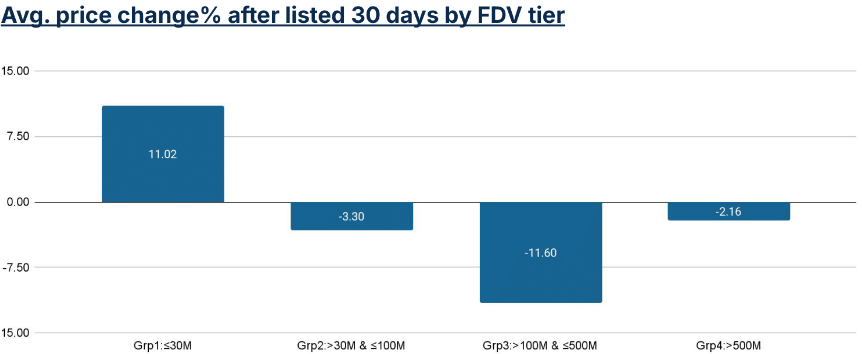
Monthly Summary of Listing Price Performance
From a time perspective, price performance is mainly driven by market conditions. During BTC bull markets, token listings perform neutrally or positively. During BTC bear markets, token listings perform negatively.
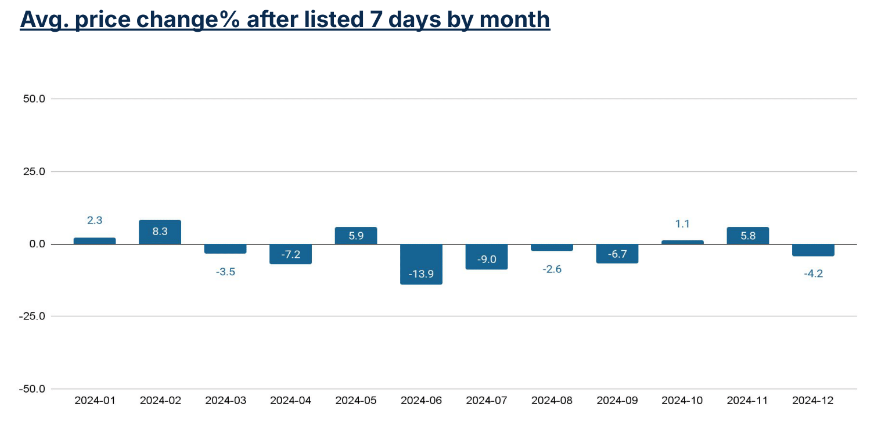
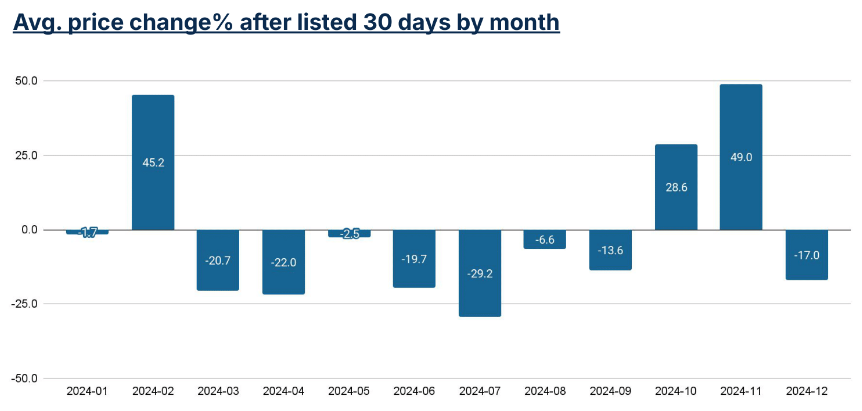
Monthly Listing Price Performance by Exchange
In February, October, and November, the price changes of most exchanges remained positive, while BTC prices rose significantly at that time.
January and May deviated from the overall BTC price trend: although BTC was about to rebound, the price performance of tokens listed in January was poor; although May was in a slow bear market, the tokens listed in May performed well.
Despite a neutral market, the price performance of tokens listed in December was poor.
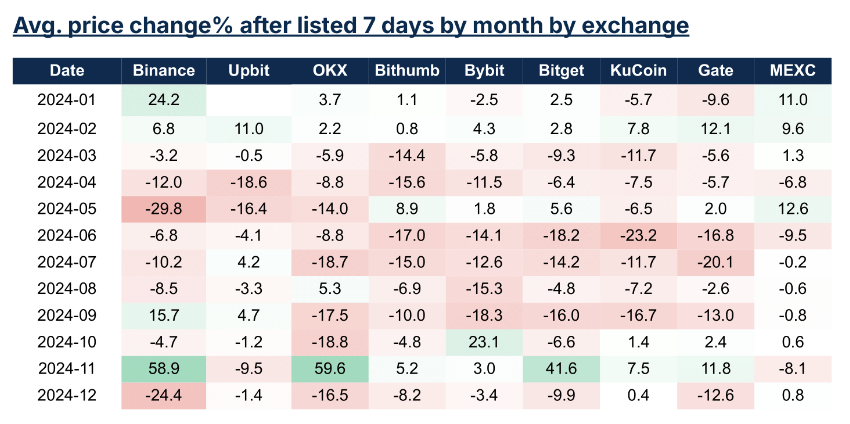
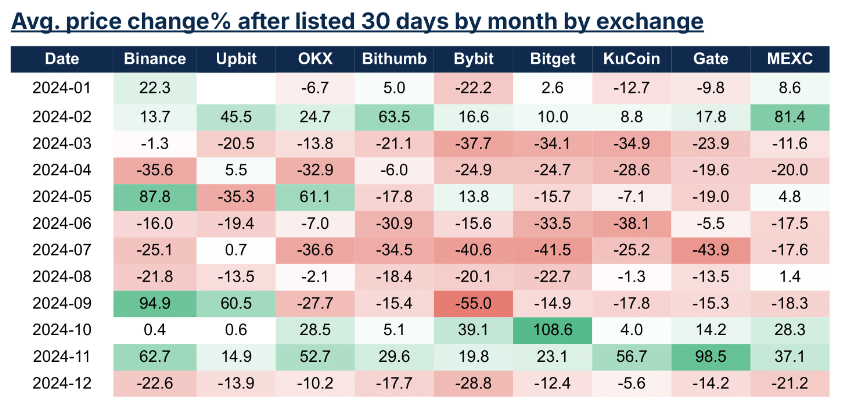
Listing Price Performance Summarized by FDV Tier
Compared to large exchanges like OKX and Bybit, the price performance of small FDV token listings is better on medium-sized exchanges like KuCoin, Gate, and MEXC.
The listing performance of medium FDV tokens ($30 million to $500 million) is better on large exchanges than on medium-sized exchanges. The listing performance of large FDV tokens (>$500 million) is relatively consistent across exchanges, with small price fluctuations from day 7 to day 30.
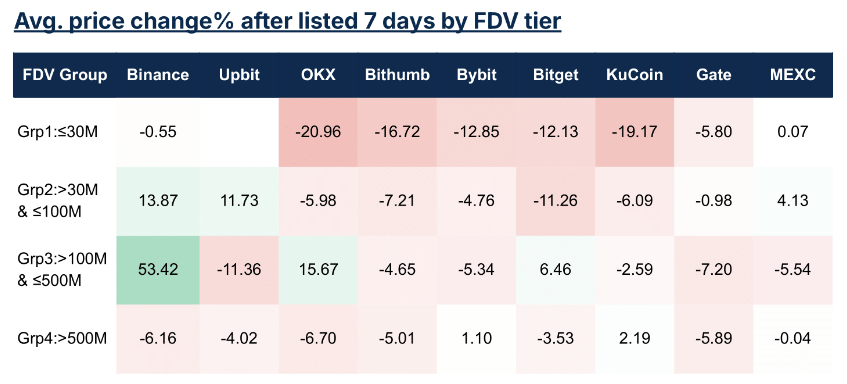
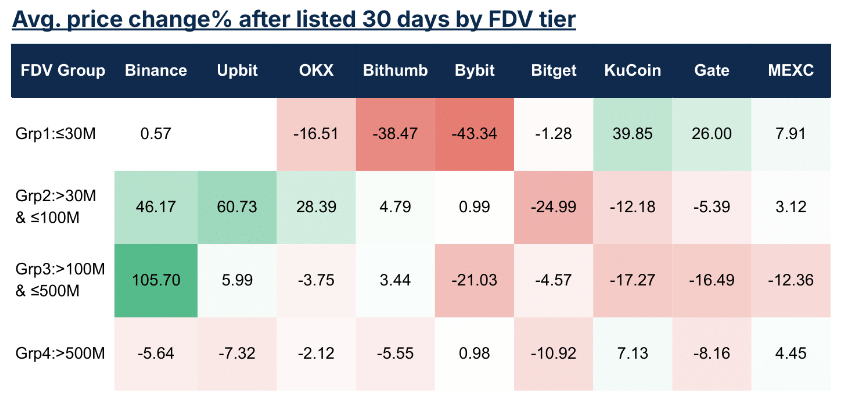
Monthly Listing Price Performance by FDV Tier
Small FDV tokens have shown strong price performance, with their 30-day price change rate outperforming medium FDV tokens ($30 million to $500 million) in most months, regardless of whether the market is in a bull or bear phase.
Medium FDV tokens experienced strong 7-day price increases in October and November, but still lagged behind other categories at 30 days.
Large FDV tokens have shown more consistency in their performance over several months, with half of the months seeing positive 7-day and 30-day price performance.
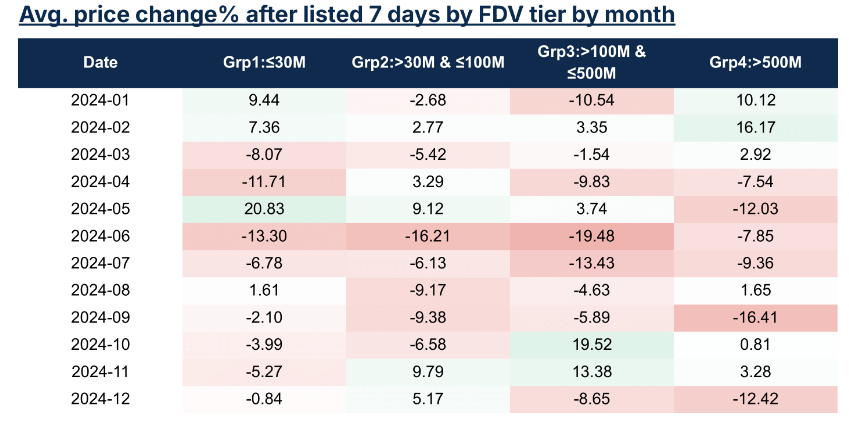
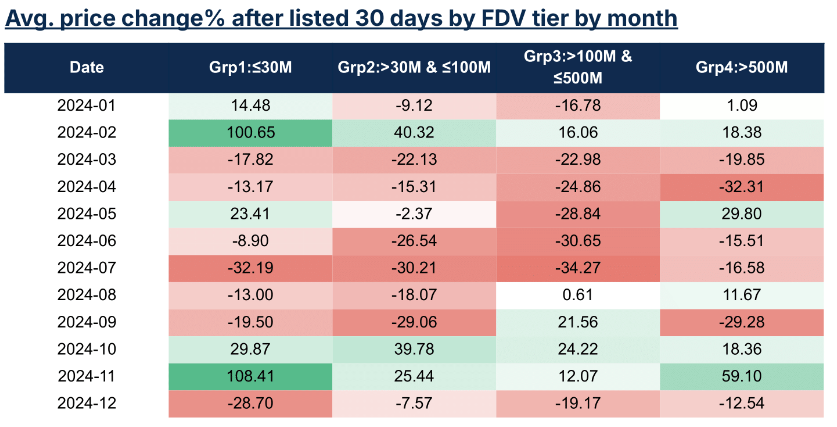
Exchange Trading Volume
Binance leads in trading volume for newly listed tokens, followed by Upbit and OKX. Upbit has strong initial 24-hour trading volume, nearly on par with Binance, but its 30-day trading volume has fallen to a level similar to OKX.
Among medium-sized exchanges, Bybit has shown strong trading volume both in the first 24 hours and over the entire 30 days.
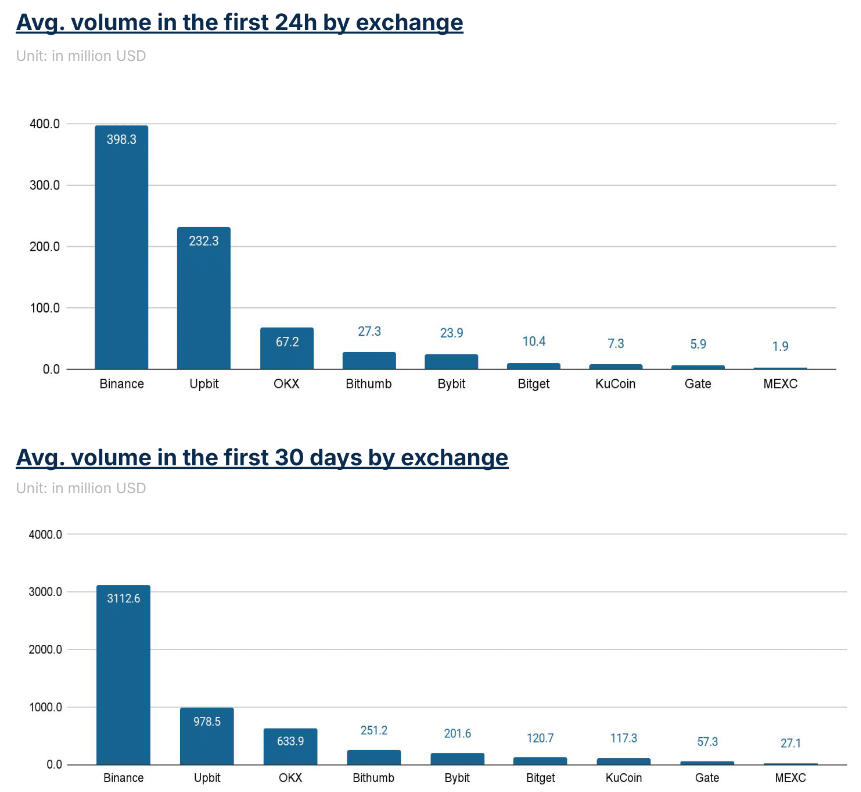
Monthly Trading Volume Summary
The trading volume of newly listed tokens largely follows the bull/bear market cycle, with higher volumes during the periods of February to March and September to December.
In April, the month after the first price surge, listing activity exceeded expectations, but trading volume was lower than the 30-day average. This suggests that excessive listings during relatively calm market periods may dilute the trading volume of newly listed tokens.
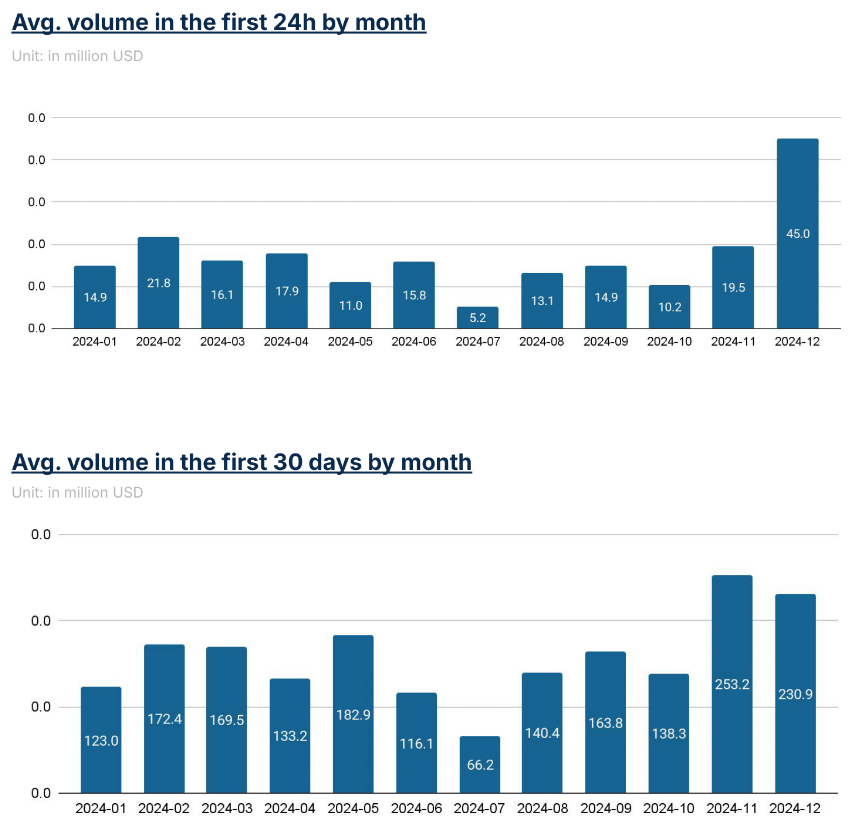
Trading Volume by FDV Tier
Trading volume generally follows the FDV tier of the tokens, with the largest FDV tier having 60 times the 24-hour trading volume and 25 times the 30-day trading volume of the smallest FDV tier.
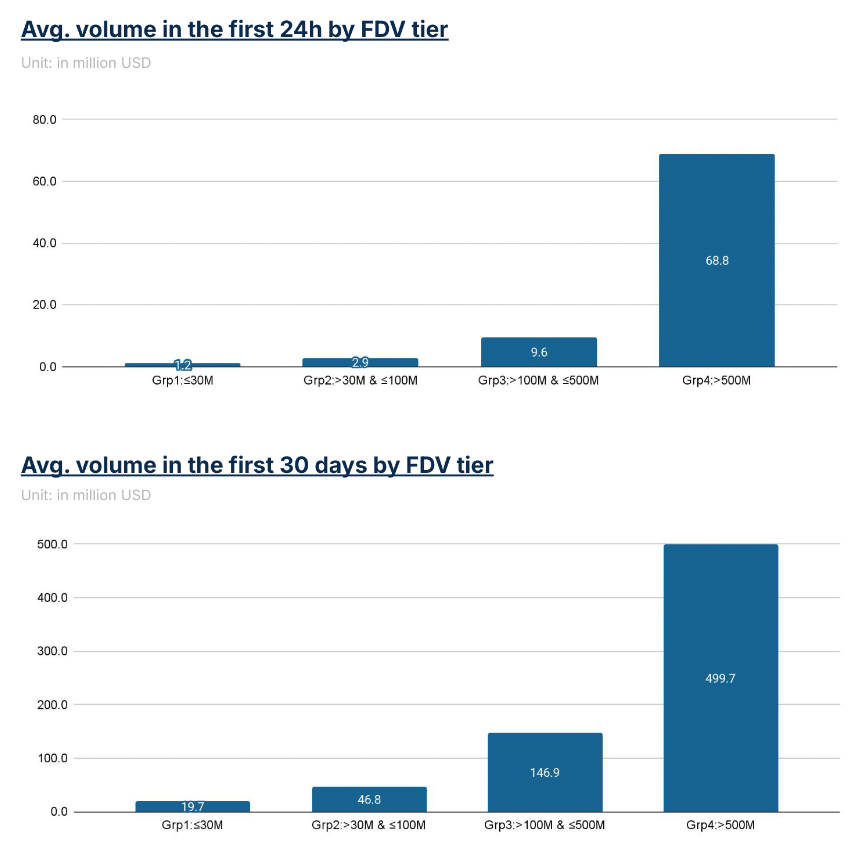
Monthly Trading Volume Summary by Exchange
In most months, Binance leads in trading volume for newly listed tokens. Upbit's newly listed tokens have shown high uncertainty in initial trading volume.
While it led in 30-day trading volume in February, July, and December, there were also several months where the trading volume of its newly listed tokens was very low.
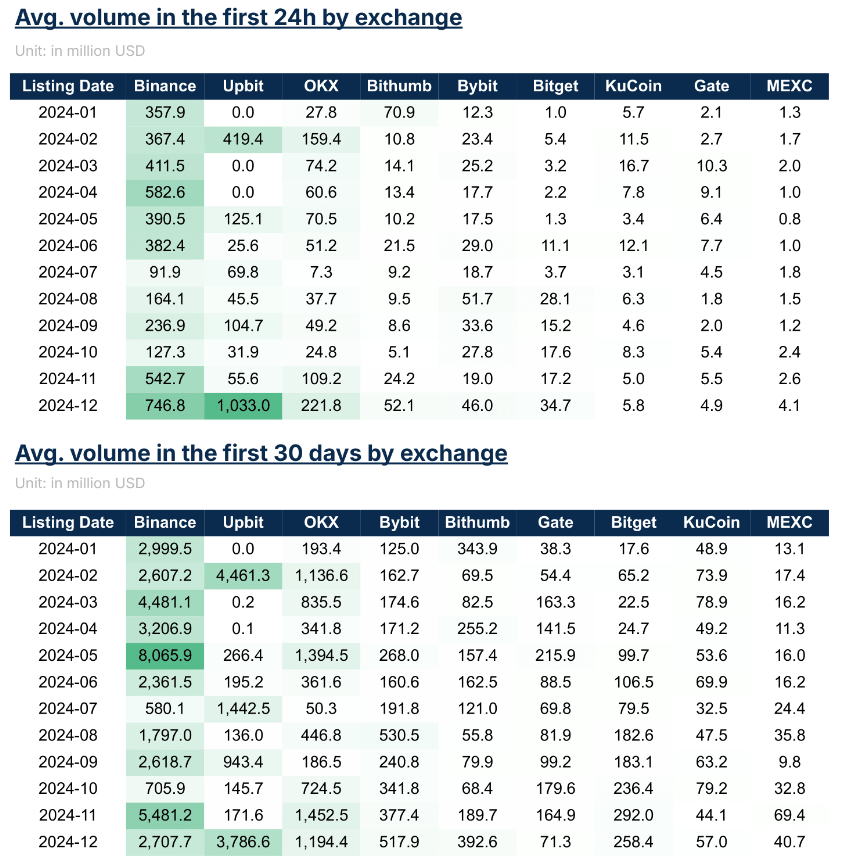
Trading Volume by FDV Tier and Exchange
Binance has the highest trading volume for listed tokens, mainly concentrated in the $100 million to $500 million FDV category.
On the other hand, OKX has significant trading volume for medium-FDV tokens ($30 million to $100 million).
Among medium-sized exchanges, Bybit has relatively stable trading volume across all FDV tiers, while other medium-sized exchanges typically have trading volume concentrated in medium-FDV tokens.
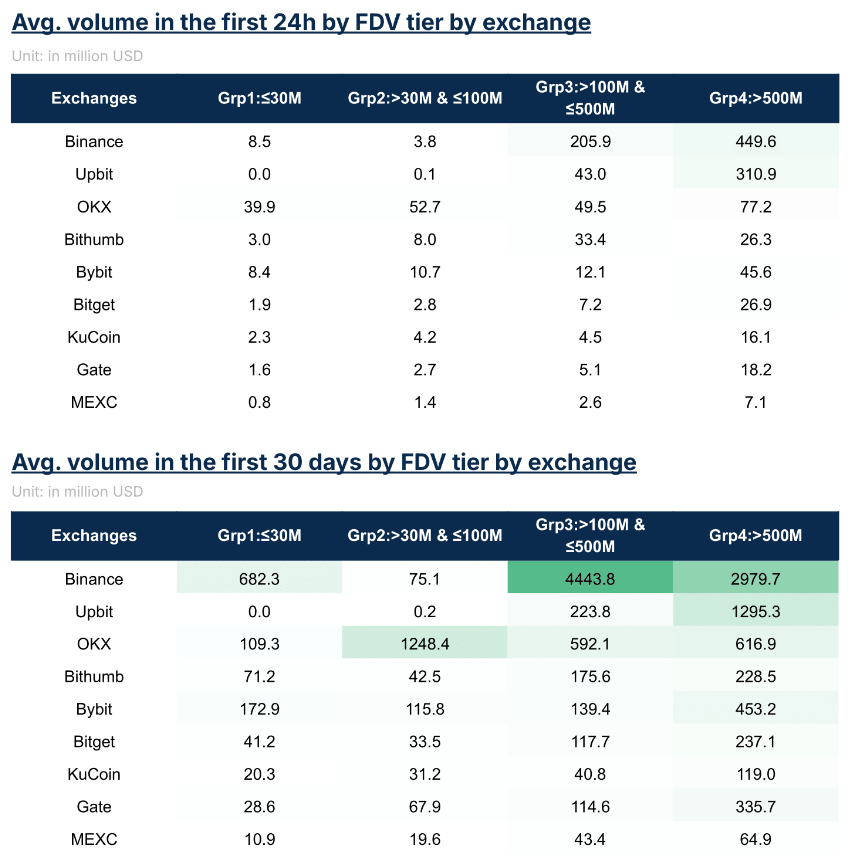
DEX vs CEX
DEX listings are often seen as a complement to CEX listings. DEX liquidity pools are typically created concurrently with the initial CEX listing, allowing users to trade flexibly on-chain or through the CEX. On the other hand, listing only on DEX is usually associated with a more decentralized approach, primarily used by mainstream tokens with limited appeal.
However, an increasing number of projects have recently chosen DEX as their sole initial listing platform, delaying or forgoing CEX listing for a period. To evaluate the feasibility and impact of this strategy, this article analyzes relevant data and metrics to compare DEX and CEX.
To ensure objective comparison, DEX listing is defined as a token that maintains liquidity exclusively on a decentralized exchange for at least 30 days. For CEX listing, the focus is on the initial listing event, representing tokens introduced as their primary trading venue on a centralized exchange. To avoid biases from long-tail tokens, the analysis is limited to tokens with a fully diluted valuation (FDV) between $30 million and $500 million to ensure balance between the two groups.
When measuring price performance, the percentage change from day 2 to day 7 and day 2 to day 30 is used, rather than the timeframe from listing to day 7 or day 30. This adjustment accounts for the different price discovery mechanisms between CEX and DEX on the listing day, as a direct comparison would otherwise be invalid. For trading volume, a consistent approach is maintained, using the first 24 hours and 30 days of trading volume as key metrics.
Listing Event Summary: DEX vs. CEX
The analysis sampled 415 major listing events that occurred in the second half of 2024, focusing on tokens with a fully diluted valuation (FDV) between $30 million and $500 million. Of these, 114 were classified as priority DEX listings, meaning the tokens were listed only on DEX in the first month.
In August, DEX listings proved to be more sensitive to market momentum, with activity rebounding in the fourth quarter after a sluggish period. In the third quarter, priority DEX listings accounted for less than 20% of new tokens, but by November and December, this proportion surged to over 30%.
Most of the CEX listings in this analysis were concentrated on mid-tier exchanges. On the other hand, Binance and OKX had only a few listing events.
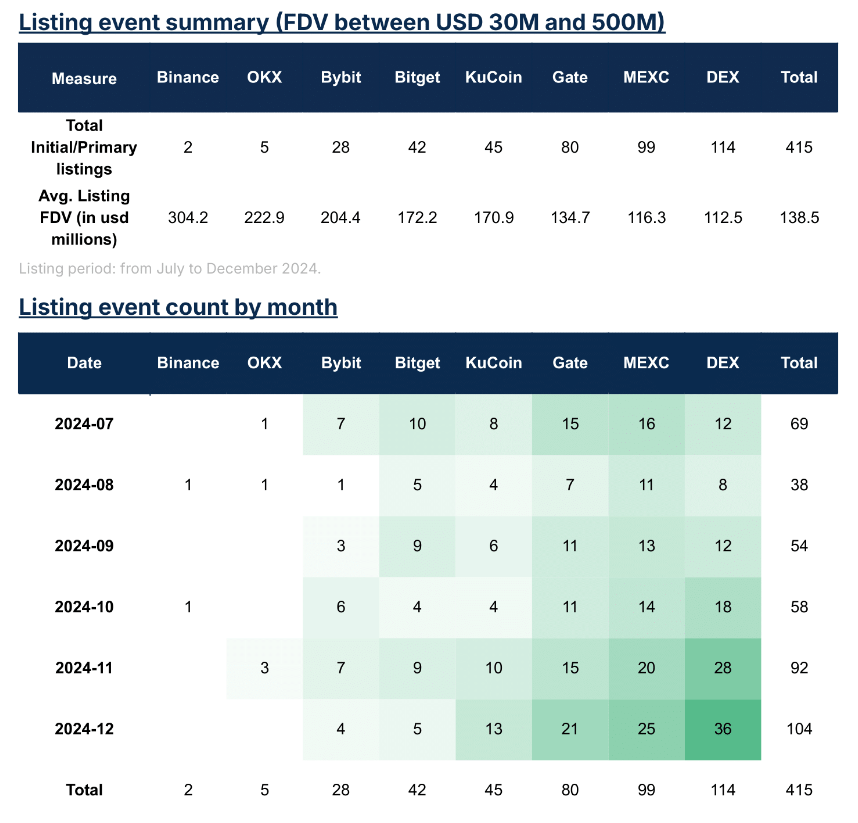
Price Changes at Initial DEX and CEX Listings
Among mid-tier CEXs, the performance from day 2 to day 7 was mixed. By day 30, all listed tokens, except those on MEXC, saw negative price changes.
In contrast, tokens initially listed on DEX showed positive growth by day 7 and a slight decline by day 30, outperforming most mid-tier CEX listed tokens.
OKX led the price performance among large CEXs, with listed tokens rising about 14% from day 2 to day 7 and maintaining this level after 30 days. However, due to limited data, caution should be exercised in interpreting the performance of Binance and OKX.
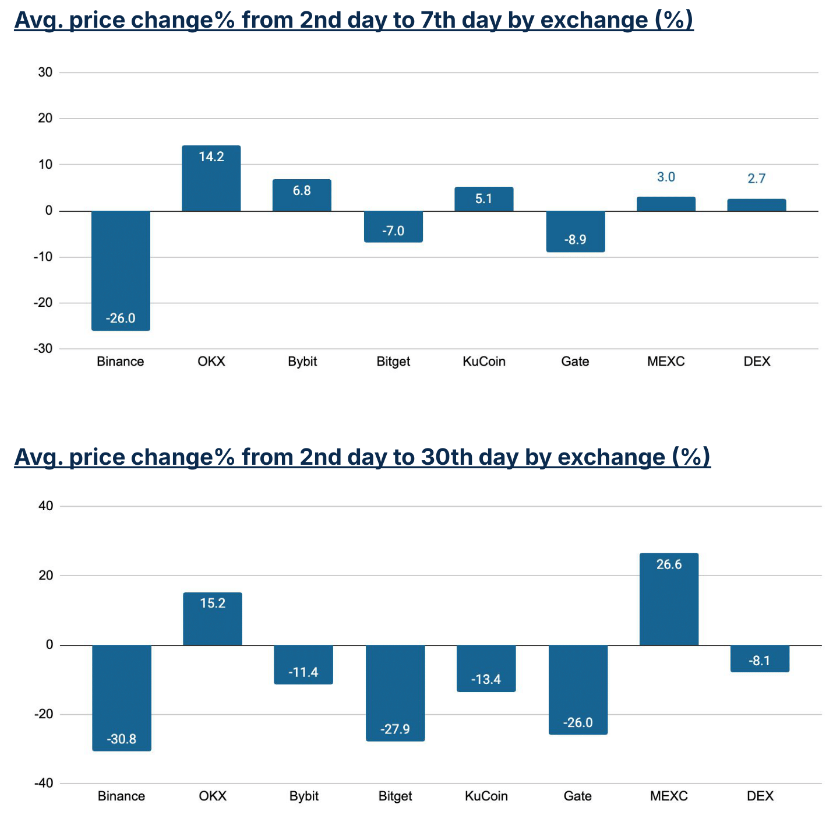
Average Trading Volume at Initial DEX and CEX Listings
The trading volume on DEX is comparable to mid-tier CEXs like Kucoin, Gate, and MEXC, while OKX and Binance have higher average trading volumes than other exchanges.
DEX and CEX show similar patterns of trading volume concentration in the first 24 hours, indicating a consistent market focus on trends.
This trading volume performance, combined with the price performance 30 days after listing, suggests that initial DEX listings can have an impact on token performance comparable to mid-tier CEXs.
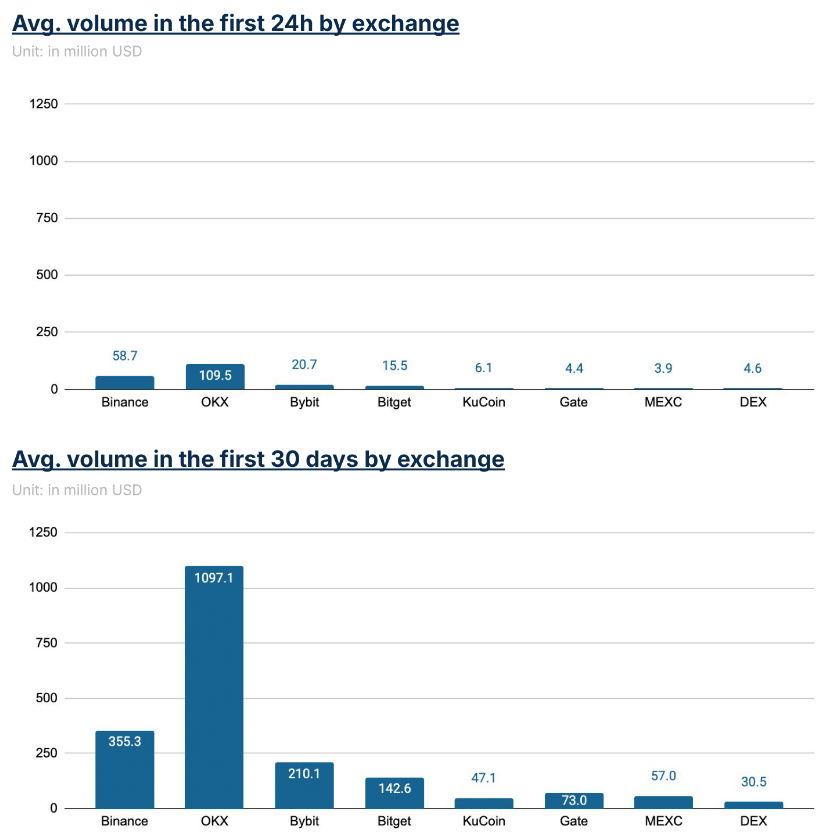
Token Listing Tier Analysis
The 415 sampled listing events cover 238 unique tokens. Of these, 126 tokens were initially listed only on DEX, while the remaining tokens were listed on mid-tier or large centralized exchanges.
It is important to note that the DEX-listed tokens analyzed are limited to those indexed on CoinMarketCap.
Among the tokens initially listed on DEX, approximately 16% later listed on CEX, primarily in the mid-tier CEX category. However, only 2% of tokens first listed on DEX subsequently gained support on top-tier CEXs (such as Binance, Upbit, or OKX). For tokens initially listed on mid-tier CEXs, about 3% eventually listed on high-FDV CEXs, a similar possibility to those first listed on DEX.
These findings suggest that while priority DEX tokens have a relatively high chance of listing on CEX, they are most likely to land on mid-tier exchanges. Regardless of whether the token starts on DEX or mid-tier CEX, the likelihood of mid-FDV tokens entering top-tier CEXs remains low.








